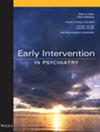Suicidal Behaviour in Adolescents With Eating Disorders: A Pandemic Timeline Comparison
Abstract
Objective
This study aimed to explore the impact of the COVID-19 pandemic on suicide attempts (SA), suicide ideation (SI), and self-harm behaviours (SHB) in adolescents with eating disorders (EDs) across four pandemic phases (pre, early, middle and late).
Methods
The prevalence of SA, SI and SHB during the pandemic was assessed retrospectively using the HEEADSSS (Home, Education/Employment, Eating, Activities, Drugs, Sexuality, Suicidal ideation and Safety) instrument of participants, with four time periods defined based on clinic visits: pre-pandemic (T0), early (T1), middle (T2) and late (T3) pandemic.
Results
Among all participants (403), 112 (27.8%) reported SHB, 137 (34%) reported SI, and 41 (10.2%) reported SA in the study across all periods. During T1 + T2 + T3 compared to T0, SHB and SI increased significantly (p < 0.001), especially at T2 and T3, while SA did not show any significant change (p = 0.124), and SHB increased in anorexia nervosa (AN) (p = 0.017), atypical anorexia nervosa (AAN) (p = 0.002), bulimia nervosa (BN) (p = 0.001) and unspecified feeding or eating disorder (UFED) (p = 0.025) groups, while SI increased by 2.2 times in the BN group (p = 0.015), but no significant change was found in SA in any of the ED groups.
Conclusions
This study indicates an increase in SI and SHB among adolescents with EDs during the pandemic, especially in the middle and late phases, highlighting the need for healthcare providers to be aware of the long-term mental health impacts of the pandemic.


 求助内容:
求助内容: 应助结果提醒方式:
应助结果提醒方式:


